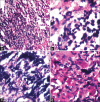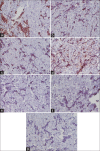Small cell neuroendocrine carcinoma of the paranasal sinus with intraoral involvement: Report of a rare case and review of the literature
- PMID: 28932042
- PMCID: PMC5596683
- DOI: 10.4103/jomfp.JOMFP_205_15
Small cell neuroendocrine carcinoma of the paranasal sinus with intraoral involvement: Report of a rare case and review of the literature
Abstract
The diffuse neuroendocrine system continues to be an enigmatic topic of study in pathology due to its controversial embryologic origins, biology and a variety of tumors engendered. Originally thought to be localized to the classic neuroendocrine organs (pituitary, thyroid, pancreas and adrenal medulla), the neuroendocrine cells are now known to be distributed in every organ system of the body. A number of human diseases have been linked to aberrations in the functioning of the neuroendocrine cells. Neoplasms of the neuroendocrine system can thus occur in myriad primary sites and range in behavior from benign to lethal. Small cell neuroendocrine carcinoma (SNEC) is a high-grade neuroendocrine tumor, rarely presenting in the sinonasal region. This article reports a case of a 68-year-old male patient with primary paranasal SNEC showing intraoral involvement. The diagnosis is based on a thorough clinical, histopathological and immunohistochemical workup to differentiate it from the other small round blue cell tumors.
Keywords: Neuroendocrine tumors; small cell neuroendocrine carcinoma; small round blue cell tumors.
Conflict of interest statement
There are no conflicts of interest.
Figures



Similar articles
-
Small cell neuroendocrine carcinoma of the paranasal sinus.Natl J Maxillofac Surg. 2013 Jan;4(1):111-3. doi: 10.4103/0975-5950.117818. Natl J Maxillofac Surg. 2013. PMID: 24163566 Free PMC article.
-
Small cell neuroendocrine carcinoma with primary orbital involvement - The unseen, and a review of literature.Indian J Pathol Microbiol. 2023 Jan-Mar;66(1):155-158. doi: 10.4103/ijpm.ijpm_1144_21. Indian J Pathol Microbiol. 2023. PMID: 36656229 Review.
-
Carcinoma with Triphasic Differentiation Arising from Inverted Papilloma in Sinonasal Sinus: A Rare Case with Molecular Characterization.Diagnostics (Basel). 2021 Oct 3;11(10):1827. doi: 10.3390/diagnostics11101827. Diagnostics (Basel). 2021. PMID: 34679524 Free PMC article.
-
Unusual Presentation of a Sphenoidal Sinus Neuroendocrine Tumor: A Case Report and Review of Literature.Cureus. 2021 Mar 4;13(3):e13689. doi: 10.7759/cureus.13689. Cureus. 2021. PMID: 33833913 Free PMC article.
-
Sinonasal Small Round Blue Cell Tumors: An Immunohistochemical Approach.Surg Pathol Clin. 2017 Mar;10(1):103-123. doi: 10.1016/j.path.2016.10.005. Epub 2016 Dec 28. Surg Pathol Clin. 2017. PMID: 28153129 Review.
Cited by
-
[Clinical characteristics of neuroendocrine carcinoma of nose and skull base and analysis of curative effect of endoscopic surgery].Lin Chuang Er Bi Yan Hou Tou Jing Wai Ke Za Zhi. 2021 Aug;35(8):740-745. doi: 10.13201/j.issn.2096-7993.2021.08.014. Lin Chuang Er Bi Yan Hou Tou Jing Wai Ke Za Zhi. 2021. PMID: 34304537 Free PMC article. Chinese.
References
-
- Betton GR. Toxicology of the diffuse neuroendocrine system. In: Atterwill CK, Flack JD, editors. Endocrine Toxicology. Cambridge: Cambridge University Press; 1992. pp. 472–5.
-
- Leong AS, Wick MR, Swanson PE. The anaplastic round cell tumors. In: Leong AS, Wick MR, Swanson PE, editors. Immunohistology and Electron Microscopy of Anaplastic and Pleomorphic Tumors. United Kingdom: Cambridge University Press; 1997. pp. 118–20.
-
- Klimstra DS, Modlin IR, Coppola D, Lloyd RV, Suster S. The pathologic classification of neuroendocrine tumors: A review of nomenclature, grading, and staging systems. Pancreas. 2010;39:707–12. - PubMed
-
- Pan J, Yeger H, Cutz E. Innervation of pulmonary neuroendocrine cells and neuroepithelial bodies in developing rabbit lung. J Histochem Cytochem. 2004;52:379–89. - PubMed
Publication types
LinkOut - more resources
Full Text Sources
Other Literature Sources

